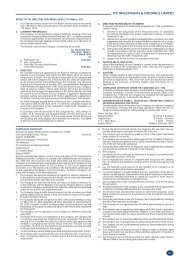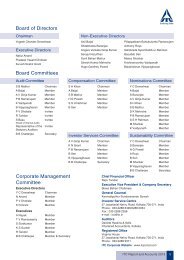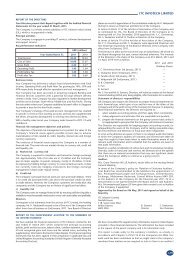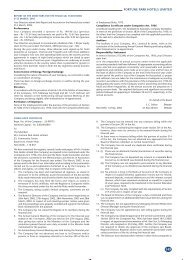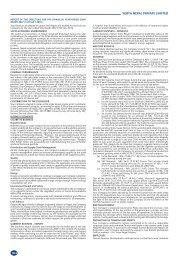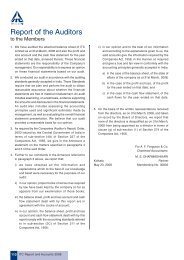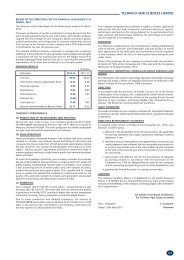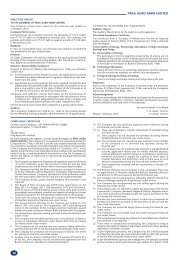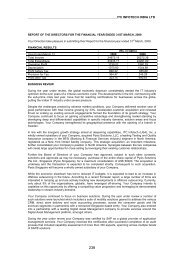SUBSIDIARY COMPANIES - ITC Ltd
SUBSIDIARY COMPANIES - ITC Ltd
SUBSIDIARY COMPANIES - ITC Ltd
You also want an ePaper? Increase the reach of your titles
YUMPU automatically turns print PDFs into web optimized ePapers that Google loves.
NOTES TO THE FINANCIAL STATEMENTS<br />
Note No.<br />
NATURE OF OPERATIONS<br />
<strong>ITC</strong> Infotech India Limited (”the Company”) is a wholly owned subsidiary of <strong>ITC</strong><br />
Limited (”the Holding Company”) providing information technology solutions and<br />
software development services.<br />
1 SIGNIFICANT ACCOUNTING POLICIES<br />
a) Convention<br />
To prepare financial statements in accordance with applicable Accounting Standards<br />
in India. A summary of important accounting policies, which have been applied<br />
consistently, is set out below. The financial statements have also been prepared in<br />
accordance with relevant presentational requirements of the Companies Act, 1956.<br />
b) Basis of Accounting<br />
To prepare financial statements in accordance with the historical cost convention.<br />
c) Revenue Recognition<br />
To recognise revenues from services performed on a “time and material” basis, as<br />
and when the services are performed.<br />
To recognise revenues from services performed on “time bound fixed-price<br />
engagements” using the percentage of completion method of accounting, if work<br />
completed can be reasonably estimated. The cumulative impact of any revision in<br />
estimates of the percentage of work completed is reflected in the period in which<br />
the change becomes known. Provisions for estimated losses on such engagements<br />
are made during the period in which a loss becomes probable and can be reasonably<br />
estimated.<br />
To recognise revenue from trading in software packages / licenses / hardware upon<br />
delivery to customer.<br />
To treat amounts received or billed in advance of services performed as unearned<br />
revenue. Unbilled revenue, included in debtors, represents amounts recognised<br />
based on services performed in advance of billing in accordance with contract terms.<br />
d) Fixed Assets<br />
To state fixed assets at actual cost less accumulated depreciation. The actual cost<br />
capitalised includes material cost, freight, installation cost, duties and taxes, finance<br />
charges and other incidental expenses incurred during the construction / installation<br />
stage.<br />
To capitalise software where it is expected to provide future enduring economic<br />
benefits. Capitalisation costs include license fees and costs of implementation /<br />
system integration services. The costs are capitalised in the year in which the relevant<br />
software is implemented for use.<br />
e) Capital Work-in-Progress<br />
To treat cost of assets not put to use before the year-end as capital work-in-progress.<br />
f) Depreciation<br />
To calculate depreciation on fixed assets on the straight-line method over their<br />
estimated useful lives at the rates, which are not less than those prescribed under<br />
Schedule XIV of the Companies Act, 1956.<br />
The cost of and the accumulated depreciation for fixed assets sold, retired or otherwise<br />
disposed off are removed from the stated values and the resulting gains and / or<br />
losses are included in the Statement of Profit and Loss.<br />
The estimated useful lives of fixed assets are as follows:<br />
Buildings 25 years<br />
Plant and Machinery - Computers / Computer Accessories 3 to 5 years<br />
Other Equipment 5 years<br />
Furniture and Fixtures 5 years<br />
Motor Vehicles 5 years<br />
Leasehold Improvements Shorter of lease period or estimated useful lives<br />
Capitalised software costs are amortised on the straight-line method over a period<br />
of five years or over the estimated useful lives, as is appropriate.<br />
g) Impairment of Assets<br />
Impairment loss, if any, is provided to the extent, the carrying amount of assets<br />
exceed their recoverable amount. Recoverable amount is higher of an asset’s net<br />
124<br />
<strong>ITC</strong> INFOTECH INDIA LIMITED<br />
selling price and its value in use. Value in use is the present value of estimated future<br />
cash flows expected to arise from the continuing use of an asset and from its disposal<br />
at the end of its useful life.<br />
h) Investments<br />
To state Current Investments at lower of cost and fair value; and Long-Term<br />
Investments, including in Joint Ventures and Associates, at cost. Where applicable,<br />
provision is made to recognise a decline, other than temporary, in valuation of<br />
Long-Term Investments.<br />
i) Proposed Dividend<br />
To provide for Dividends as proposed by the Directors in the books of accounts,<br />
pending approval at the Annual General Meeting.<br />
j) Research and Development<br />
To charge off all revenue expenditure incurred on research and development in the<br />
year it is incurred. Assets purchased for research and development activities are<br />
included in fixed assets.<br />
k) Taxes on Income<br />
To provide and determine current tax as the amount of tax payable in respect of<br />
taxable income for the period.<br />
To provide and recognise deferred tax on timing differences between taxable income<br />
and accounting income subject to consideration of prudence.<br />
Not to recognise deferred tax assets on unabsorbed depreciation and carry forward<br />
losses unless there is virtual certainty that there will be sufficient future taxable<br />
income available to realise such assets.<br />
l) Foreign Currency Translation<br />
To account for transactions in foreign currency at the exchange rate prevailing on<br />
the date of transactions. Gains / losses arising out of fluctuations in the exchange<br />
rates are recognized in the Statement of Profit and Loss in the period in which<br />
they arise.<br />
To account for differences between the forward exchange rates and the exchange<br />
rates at the date of transactions, as income or expense over the life of the contracts.<br />
To account for profit / loss arising on cancellation or renewal of forward exchange<br />
contracts as income / expense for the period.<br />
To account for gains / losses on foreign exchange rate fluctuations relating to current<br />
assets and liabilities at the Balance Sheet date.<br />
To translate the financial statements of the foreign branch offices of the Company<br />
using the same principles and procedures stated above as the operations of such<br />
branches are integral in nature.<br />
m) Employee Benefits<br />
To make regular monthly contributions to various Provident Funds which are in the<br />
nature of defined contribution scheme and to charge such paid / payable amounts<br />
against revenue. To administer through duly constituted and approved independent<br />
trusts such Funds.<br />
To administer through duly constituted and approved independent trusts, various<br />
Gratuity and Pension Funds which are in the nature of defined benefit schemes. The<br />
liabilities towards such schemes including employee leave encashment are ascertained<br />
by an independent actuarial valuation as per the requirements of Accounting<br />
Standard - 15 (revised 2005) on “Employee Benefits”. To determine actuarial gains<br />
or losses as the difference between the actual and expected returns on plan assets,<br />
effect of changes in discount rates, unexpectedly high or low rates of employee<br />
turnover, early retirements, mortality or increase in salary benefits and the effect of<br />
changes in any other actuarial assumptions and to recognise such gains and losses<br />
immediately in the Statement of Profit and Loss as income or expense.<br />
n) Claims<br />
To disclose claims against the Company not acknowledged as debts after a careful<br />
evaluation of the facts and legal aspects of the matter involved.<br />
o) Segment Reporting<br />
To identify segments having regard to the dominant source and nature of risks and<br />
returns and the internal organisation and management structure.




